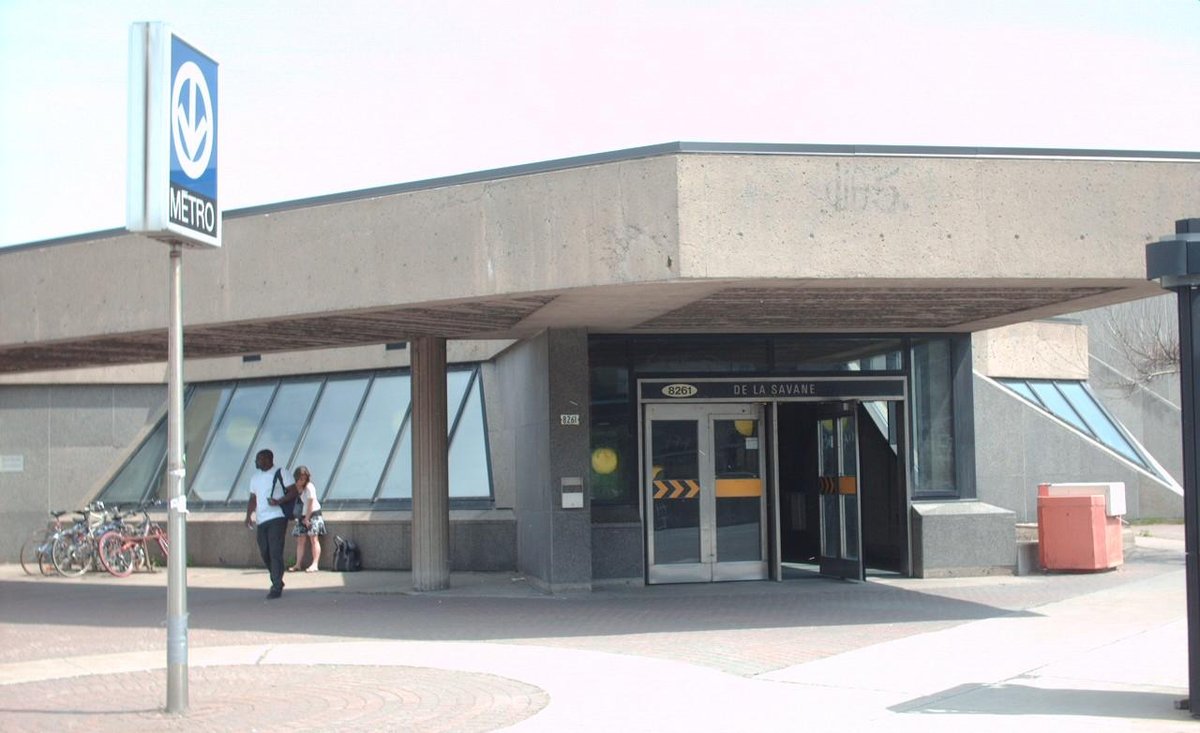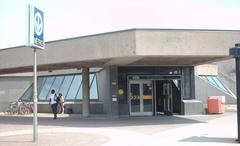
De La Savane Montreal: Visiting Hours, Tickets, and Historical Sites Guide
Date: 15/06/2025
Introduction: History and Significance of De La Savane
Located in Montreal’s Côte-des-Neiges–Notre-Dame-de-Grâce borough, De La Savane stands at the intersection of the city’s industrial past and its urban renewal aspirations. Once characterized by warehouses and factories, the district’s strategic position—at the crossroads of major expressways and metro lines—has made it a keystone of Montreal’s transit and logistical network since the early 20th century. Today, visitors encounter a dynamic tapestry: the historic Baron de Hirsch Cemetery, the striking Brutalist De La Savane Metro Station, and ambitious redevelopment projects like the Écoquartier Namur-Hippodrome. These landmarks, together with ongoing efforts to foster sustainability and social inclusion, define De La Savane as a compelling destination for those interested in history, architecture, or urban transformation. For up-to-date details, consult resources such as the Montreal Urban Plan, Société de transport de Montréal (STM), and Montreal Heritage Sites.
Contents
- Introduction
- Early History and Geographic Setting
- Industrialization and Urban Morphology
- Postwar Urban Development and Demographic Shifts
- Recent Urban Planning and Redevelopment Initiatives
- Key Redevelopment Projects
- Regulatory Framework
- Visiting De La Savane: Practical Information
- Baron de Hirsch Cemetery
- Getting There
- Nearby Attractions
- Contemporary Urban Landscape and Visitor Experience
- De La Savane Metro Station Guide
- Historical Context and Naming
- Architectural Features
- Connectivity and Transit Integration
- Usage and Significance
- Visiting Hours, Tickets, and Frequency
- Practical Visitor Tips
- Visiting the Historic Hippodrome de Montréal (Blue Bonnets)
- Historical Significance
- Visiting Hours and Ticket Information
- Getting There and Accessibility
- Guided Tours and Special Events
- Nearby Attractions
- Photography Tips
- Frequently Asked Questions (FAQ)
- Conclusion
- References and Further Reading
Early History and Geographic Setting
De La Savane sits in central-west Montreal, bordered by Autoroute 40 (Metropolitan Expressway) and Autoroute Décarie. Its flat terrain and proximity to transit routes led to early development as an industrial and service corridor (Montreal Urban Plan). The addition of De La Savane Metro Station in 1984 further bolstered its role as a transportation hub.
Industrialization and Urban Morphology
Throughout the 20th century, De La Savane was defined by low-rise industrial buildings that separated residential zones from busy highways. A significant landmark, the Baron de Hirsch Cemetery, was established in 1905 and remains one of Canada’s largest Jewish burial grounds, with more than 55,000 interments and notable Holocaust memorials (Baron de Hirsch Cemetery Wikipedia). The cemetery embodies the area’s multicultural heritage.
Postwar Urban Development and Demographic Shifts
The construction of Autoroute 40 in the 1960s and expansions to the Décarie Expressway cemented De La Savane’s status as a transit and industrial hub, though these developments limited residential growth. Surrounding neighborhoods evolved into diverse, vibrant communities, while De La Savane maintained a lower population density but high strategic importance due to its connectivity.
Recent Urban Planning and Redevelopment Initiatives
Recognizing De La Savane’s potential, Montreal’s Urban Plan has prioritized its transformation into a sustainable, inclusive neighborhood. The Namur-Hippodrome redevelopment focuses on converting former industrial lands into ecological, carbon-neutral residential spaces (Montreal Urban Plan).
Key Redevelopment Projects
- Jardins De La Savane Project: Transforming former industrial sites near Namur Metro into a modern 12-story residential tower and a 7-story social housing building, promoting higher-density, transit-oriented living (IMTL).
- Affordable and Social Housing: New developments, such as an affordable housing building at 5460 avenue Connaught and an 18-story social housing tower on chemin de la Côte-Saint-Luc, reflect a commitment to social inclusion (Montreal Urban Plan).
- Écoquartier Namur-Hippodrome: This eco-neighborhood initiative, shaped by public consultations, prioritizes sustainability, green spaces, and community resilience (Montreal Urban Plan).
Regulatory Framework
Urban Plan amendments support residential and mixed-use projects, with updated zoning and demolition bylaws ensuring thoughtful integration of new developments and heritage preservation (Montreal Urban Plan).
Visiting De La Savane: Practical Information
Baron de Hirsch Cemetery
- Visiting Hours: Open during daylight hours; check ahead for specifics.
- Admission: Free.
- Accessibility: Paved paths and accessible facilities.
- Tours: Occasional guided tours via local heritage groups.
Getting There
- Metro: De La Savane and Namur stations (Orange Line).
- Bus: Served by multiple STM routes.
- Car: Accessible from Autoroute 40 and Décarie, with nearby parking.
Nearby Attractions
- Blue Bonnets (Hippodrome) Site: Former racetrack, now being redeveloped.
- Côte-des-Neiges Neighborhood: Diverse dining and shopping.
- Parc de la Savane: Green space adjacent to the metro station (Montreal Parc de la Savane).
Contemporary Urban Landscape and Visitor Experience
Visitors to De La Savane encounter a district in transition: historic industrial buildings, new eco-friendly residential towers, vibrant multicultural communities, and a growing array of public amenities. It serves as a starting point for exploring Montreal’s west end and offers insight into the city’s evolving urban identity.
De La Savane Metro Station Guide
Historical Context and Naming
Opened in 1984, De La Savane Metro Station’s name is derived from Rue de la Savane, recalling the area’s rural past. The station is located near the Town of Mount Royal border, in a district once marked by open fields and marshland.
Architectural Features
- Design: The station’s raw concrete (béton brut) and angular forms typify Brutalist architecture, designed by Guy de Varennes and Almas Mathieu.
- Artistic Elements: “Calcite,” a stainless steel sculpture by Maurice Lemieux, is illuminated by a skylight, playing with light and shadow (STM Info).
- Layout: Underground with two side platforms; a single entrance at 8261 Boulevard Décarie.
Connectivity and Transit Integration
- Metro: Between Namur and Du Collège stations on the Orange Line, offering direct access downtown.
- Bus: Connections to routes 17, 100, 460, and several night buses; nearby Kindersley / De La Savane stop.
- Bikes: 42 outdoor bike racks and a BIXI bike-sharing station. New pedestrian bridge to Royalmount under construction as of 2023.
Usage and Significance
Despite its architectural merit, De La Savane is among the least used in the network, owing to its commercial surroundings. The adjacent Royalmount development is expected to increase traffic.
Visiting Hours, Tickets, and Frequency
- Operating Hours: First train toward Montmorency at 5:32 AM; last at 12:32 AM (1:02 AM Saturdays). Last train to Côte-Vertu at 1:18 AM (1:48 AM Saturdays).
- Frequency: Every 3–12 minutes, depending on the time of day.
- Ticketing: Purchase single-ride tickets, day passes, or OPUS cards at station vending machines or online (STM Fares).
- Accessibility: As of June 2025, the station is not fully accessible (no elevators/escalators).
Practical Visitor Tips
- Amenities: Ticket machines, bike parking, BIXI station. Retail options nearby on Boulevard Décarie.
- Safety: Monitored by STM security; generally safe, but quieter during off-peak hours.
- Future Developments: The Royalmount pedestrian bridge will enhance access to new commercial and entertainment venues.
Visiting the Historic Hippodrome de Montréal (Blue Bonnets)
Historical Significance
Once Montreal’s premier horse racing venue, the Hippodrome de Montréal (Blue Bonnets) was a focal point for social events and sporting history. Though racing ceased in the late 1990s, the site is central to current urban revitalization efforts (Montreal Heritage Sites).
Visiting Hours and Ticket Information
- Hours: 9:00 AM–6:00 PM daily; guided tours on weekends (10:00 AM–4:00 PM).
- Admission: Free for self-guided visits; guided tours $10/adult, $5/seniors/students, free for children under 12.
- Booking: Reserve tours via the Montréal Heritage Sites website.
Getting There and Accessibility
- Transit: Close to Namur and De La Savane metro stations; accessible by bus and cycling paths.
- Accessibility: Wheelchair-friendly with ramps and designated parking.
Guided Tours and Events
Guided tours highlight the Hippodrome’s architecture, cultural impact, and notable events. Seasonal programs and exhibitions celebrate local heritage; check the official website for updates.
Nearby Attractions
- Parc de la Savane: Ideal for relaxation.
- Downtown Montréal: Museums, shopping, dining a short metro ride away.
- Local Cafés and Boutiques: In the surrounding neighborhoods.
Photography Tips
Best lighting during golden hour; photography welcome except in restricted areas.
Frequently Asked Questions (FAQ)
Q: Can I visit the Baron de Hirsch Cemetery?
A: Yes, during daylight hours. Respectful behavior is expected.
Q: Are guided tours available for the cemetery or the district?
A: Occasionally, via local heritage organizations.
Q: How do I get to De La Savane by public transit?
A: Orange Line metro (De La Savane or Namur) or multiple STM bus routes.
Q: Are there entrance fees for redevelopment sites or new buildings?
A: Redevelopment sites are private; parks and public spaces are open to all.
Q: Is De La Savane Metro Station accessible for people with disabilities?
A: As of June 2025, the station lacks full accessibility.
Q: Are there parking options at De La Savane Metro Station?
A: No dedicated car parking, but ample bike parking and bike-sharing.
Q: Can I host private events at the Hippodrome site?
A: Yes; contact the city’s heritage office for rental information.
Conclusion
De La Savane is a microcosm of Montreal’s evolution—from industrial roots and vital transit functions to its present-day transformation as a sustainable, inclusive neighborhood. Key sites like the Baron de Hirsch Cemetery and De La Savane Metro Station offer historical and architectural interest, while projects such as Écoquartier Namur-Hippodrome and the redevelopment of Blue Bonnets highlight the city’s progressive urban vision. With robust transit connectivity and growing public amenities, De La Savane invites exploration from history buffs, architecture enthusiasts, and urban explorers alike.
For current schedules, ticketing, and tours, refer to official sources like the STM website and Montreal Heritage Sites. Enhance your visit with the Audiala app for guided audio tours, and stay updated via social media and related articles on Montreal’s evolving cityscape.
References and Further Reading
- Exploring De La Savane: Montreal’s Historic Industrial District and Urban Renewal (montreal.ca)
- De La Savane Metro Station Visiting Hours, Tickets, and Architectural Highlights in Montreal (stm.info), (imtl.org)
- Visiting De La Savane Metro Station and Nearby Attractions in Montreal (stm.info), (montreal.ca - Parc de la Savane)
- Visiting the Historic Hippodrome de Montréal (Blue Bonnets) (ville.montreal.qc.ca/heritage)




























































































































